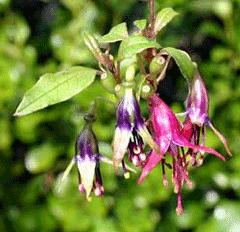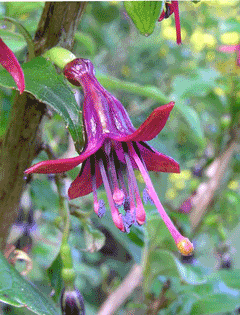 |
|
|
 |
| http://commons.wikimedia.org/wiki/User:Tony_WillsFuchsia fulgens |
Translate this page:
Summary
Physical Characteristics

 Fuchsia excorticata is a deciduous Shrub growing to 10 m (32ft 10in) at a medium rate.
Fuchsia excorticata is a deciduous Shrub growing to 10 m (32ft 10in) at a medium rate.
See above for USDA hardiness. It is hardy to UK zone 9 and is frost tender. It is in flower from May to June. The species is hermaphrodite (has both male and female organs) and is pollinated by Insects.
It is noted for attracting wildlife.
Suitable for: light (sandy), medium (loamy) and heavy (clay) soils and prefers well-drained soil. Suitable pH: mildly acid, neutral and basic (mildly alkaline) soils. It can grow in semi-shade (light woodland) or no shade. It prefers moist soil. The plant can tolerates strong winds but not maritime exposure.
UK Hardiness Map
US Hardiness Map
Synonyms
Skinnera excorticata.
Plant Habitats
Woodland Garden Sunny Edge; Dappled Shade; Shady Edge;
Edible Uses
Edible Parts: Fruit Sap
Edible Uses:
Fruit - raw or cooked in pies, tarts, cakes, desserts etc[3, 173, 183]. Juicy[11]. A juicy berry[K], it is sweet but astringent[153]. A unique flavour, they are best combined with potato flour or corn starch in order to temper the slight astringency[183]. Sap - sweet. Obtained by cutting a length of branch and sucking out the sap, it is not freely produced however[173].
References More on Edible Uses
Medicinal Uses
Plants For A Future can not take any responsibility for any adverse effects from the use of plants. Always seek advice from a professional before using a plant medicinally.
None known
References More on Medicinal Uses
The Bookshop: Edible Plant Books
Our Latest books on Perennial Plants For Food Forests and Permaculture Gardens in paperback or digital formats.

Edible Tropical Plants
Food Forest Plants for Hotter Conditions: 250+ Plants For Tropical Food Forests & Permaculture Gardens.
More

Edible Temperate Plants
Plants for Your Food Forest: 500 Plants for Temperate Food Forests & Permaculture Gardens.
More

More Books
PFAF have eight books available in paperback and digital formats. Browse the shop for more information.
Shop Now
Other Uses
Cosmetic Dye Ink Wood
A purple dye is obtained from the plant (the part is not specified, though it is likely to be the pollen). It makes a good ink[173]. The pollen is bright blue and was used by the Maoris as a face powder[48, 173]. Wood - very strong and durable with an attractive grain, but hard to work. Used for making small items[128].
Special Uses
Attracts Wildlife
References More on Other Uses
Cultivation details
Succeeds in any fertile well-drained circum-neutral soil, preferring one that is rich in humus[1, 200]. Prefers semi-shade and a sheltered position[1, 15]. Does well in woodland conditions[166]. This species is only hardy in the mildest parts of Britain[11, 48], tolerating temperatures down to about -10°c when fully dormant. The young growth in spring, even on mature plants, is frost-tender and so it is best to grow the plants in a position sheltered from the early morning sun[K]. It grows well outdoors in Cornwall and along the west coast of Scotland[59, 184]. Plants seem to be immune to the predations of rabbits[233]. A good bee plant[108]. A very unusual plant in that its pollen is bright blue[173].
References Carbon Farming Information and Carbon Sequestration Information
Temperature Converter
Type a value in the Celsius field to convert the value to Fahrenheit:
Fahrenheit:
The PFAF Bookshop
Plants For A Future have a number of books available in paperback and digital form. Book titles include Edible Plants, Edible Perennials, Edible Trees,Edible Shrubs, Woodland Gardening, and Temperate Food Forest Plants. Our new book is Food Forest Plants For Hotter Conditions (Tropical and Sub-Tropical).
Shop Now
Plant Propagation
Seed - best sown as soon as it is ripe[200] though it can also be sown in the spring[1]. Surface sow the seed in pots in a warm greenhouse and do not allow the compost to dry out[200]. Germination should take place in less than 6 weeks. Prick out the seedlings into individual pots when they are large enough to handle, and grow them on in the greenhouse for at least their first winter. Plant out in late spring or early summer, after the last expected frosts. Inter-nodal cuttings of greenwood, 5 - 8cm long, May/June in a frame. Quick and easy, a high percentage take[78, K]. Overwinter in the greenhouse for the first year and plant out after the last expected frosts. Inter-nodal cuttings of half-ripe wood, July/August in a frame. Very quick and easy, treat as greenwood cuttings above[K]. Cuttings usually succeed at any time during the growing season[K].
Other Names
If available other names are mentioned here
Native Range
AUSTRALASIA: New Zealand
Weed Potential
Right plant wrong place. We are currently updating this section.
Please note that a plant may be invasive in one area but may not in your area so it's worth checking.
Conservation Status
IUCN Red List of Threatened Plants Status :

Growth: S = slow M = medium F = fast. Soil: L = light (sandy) M = medium H = heavy (clay). pH: A = acid N = neutral B = basic (alkaline). Shade: F = full shade S = semi-shade N = no shade. Moisture: D = dry M = Moist We = wet Wa = water.
Now available:
Food Forest Plants for Mediterranean Conditions
350+ Perennial Plants For Mediterranean and Drier Food Forests and Permaculture Gardens.
[Paperback and eBook]
This is the third in Plants For A Future's series of plant guides for food forests tailored to
specific climate zones. Following volumes on temperate and tropical ecosystems, this book focuses
on species suited to Mediterranean conditions—regions with hot, dry summers and cool, wet winters,
often facing the added challenge of climate change.
Read More
Expert comment
Author
(J.R.Forst.&G.Forst.)L.f.
Botanical References
1144200
Links / References
For a list of references used on this page please go here
Readers comment